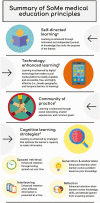The Digital Classroom: How to Leverage Social Media for Infectious Diseases Education
- PMID: 35568480
- PMCID: PMC9383968
- DOI: 10.1093/cid/ciac048
The Digital Classroom: How to Leverage Social Media for Infectious Diseases Education
Abstract
Social media (SoMe) platforms have been increasingly used by infectious diseases (ID) learners and educators in recent years. This trend has only accelerated with the changes brought to our educational spaces by the coronavirus disease 2019 pandemic. Given the increasingly diverse SoMe landscape, educators may find themselves struggling with how to effectively use these tools. In this Viewpoint we describe how to use SoMe platforms (e.g., Twitter, podcasts, and open-access online content portals) in medical education, highlight medical education theories supporting their use, and discuss how educators can engage with these learning tools effectively. We focus on how these platforms harness key principles of adult learning and provide a guide for educators in the effective use of SoMe tools in educating ID learners. Finally, we suggest how to effectively interact with and leverage these increasingly important digital platforms.
Keywords: digital strategy; infectious diseases; medical education; social media; virtual learning.
© The Author(s) 2022. Published by Oxford University Press for the Infectious Diseases Society of America. All rights reserved. For permissions, e-mail: journals.permissions@oup.com.
Figures




References
-
- Walsh AL, Peters ME, Saralkar RL, Chisolm MS.. Psychiatry Residents Integrating Social Media (PRISM): using Twitter in graduate medical education. Acad Psychiatry 2019; 43:319–23. - PubMed
Publication types
MeSH terms
LinkOut - more resources
Full Text Sources
Medical

